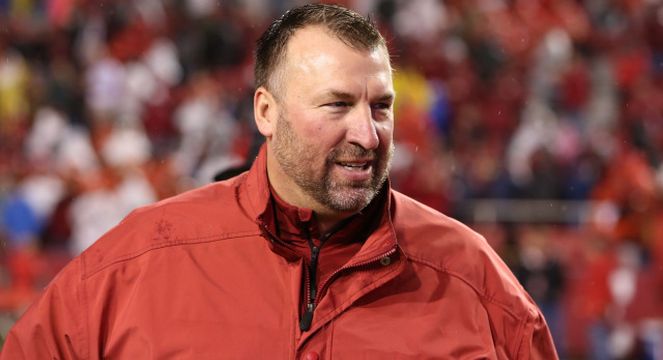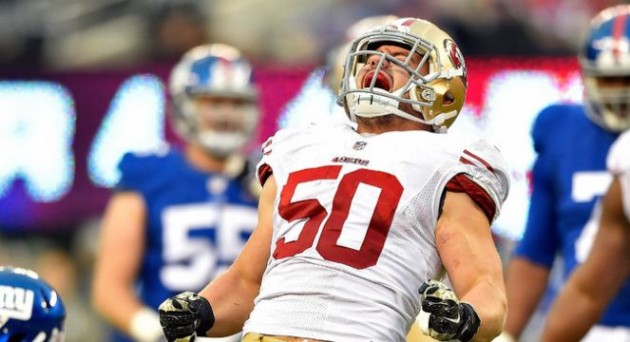Arkansas head coach goes on player safety attack after Borland retirement

The right and wrong of siding with or against speeding up or slowing down the game
Over the past two days online, radio, and television media have had a field day discussing the retirement of San Francisco 49ers linebacker Chris Borland. After one very promising year in the NFL, Borland thought better to hang up his spikes to prevent long term health risks than continue on for gridiron glory and multimillion dollar riches.
An outspoken advocate for player safety in football is Arkansas Razorbacks head coach Bret Bielema. Bielema also has a lot of insight on Borland, he recruited the Archbishop Alter High School (Kettering, Ohio) star athlete out of Ohio State’s backyard to Wisconsin as part of his 2009 recruiting class.
Among Borland’s many impressive athletic accomplishments include being named First-Team All-State in high school (2008), Big Ten Freshman of the Year in 2009, and First-Team All-Big Ten in 2011, 2012, and 2013. He was also the Big Ten Linebacker and Defensive Player of the Year in 2013. After being a 2014 third round NFL draft pick of the 49ers, the 5’11”, 248 pound, tackling machine exploded to unforeseen heights during his rookie season. Playing in 14 of 16 games, starting eight games after an injury to teammate Patrick Willis, Borland finished with 108 total tackles, 84 solo and 24 assisted, while setting the single-season league high for stops with 18 against the St. Louis Rams in his second career start.
Even though the sample size was relatively small, high hopes for the future were placed upon Borland’s shoulders as the next great 49ers linebacker. Even NFL “old timers” were quick to praise Borland’s play and ability calling him a “throwback who could play in any era.”
With all the potential and ability in the world no wonder ESPN has given the rookie linebacker so much coverage and attention despite only playing in 14 career games with just eight starts.
When Borland made his announcement The Sporting News was able to get an interview with Bielema covering his thoughts on protecting the game and the players stating, “I can’t imagine the thought process he (Borland) had to go through to get to where he was. It’s not about what we want for the game, it’s about what the game needs.
“We have an obligation to do what’s right,” Bielema added. “I can’t understand how some guys can’t see that. We have to protect student athletes to extremes we never thought of before. I just read a study that said players in the no-huddle, hurry-up offense play the equivalent of five more games than those that don’t. That’s an incredible number. Our awareness as a whole has to increase.”
Bielema has taken criticism for backing player safety in the method of his argument, by advocating for the game to be slowed down with the insertion of a 10 second rule between plays allowing for defenders to catch their breath before the next play. For a grind-it-out, Power-I, coach like Bielema, slowing down the game only plays into his on the field philosophy. That philosophy is to wind down the clock behind a strong running game to shorten the game while limiting the other team’s offensive snaps. Fewer snaps for the opposition running an up-tempo or no-huddle offense means fewer possessions and fewer chances to score.
According to TeamRankings.com, Baylor led the nation with 90.3 snaps per game while New Mexico ran just 61.9 offensive plays per game the worst in FBS in 2014. New Mexico is team No. 128 meaning that the middle or average would be team No. 64, Buffalo. Buffalo ran 73.9 plays per game compared to Arkansas’ 73.0 plays per game.
But does Bielema have a valid point about limiting the number of snaps in hopes of limiting the number of opportunities 22 different players on the field at any one time could get hurt? Even up-tempo offenses like Gus Malzahn’s at Auburn only averaged 73.5 snaps per game.
The highest snap producing offense in the SEC was Mississippi State with 80.2 snaps, or No. 16 in the nation, followed by Tennessee with 78.7 plays per game, No. 22 in the nation.
The majority of Bielema’s SEC counterparts are within close proximity on snap per game basis:
No. 16 Mississippi State, 80.2 snaps
No. 22 Tennessee, 78.7 snaps
No. 51 Kentucky, 75.0 snaps
No. 52 South Carolina, 74.8
No. 65 Texas A&M, 73.6 snaps
No. 66 Auburn, 73.5 snaps
No. 70 Arkansas, 73.0 snaps
No. 72 Alabama, 72.8 snaps
No. 75 Ole Miss, 72.5 snaps
No. 78 Florida, 72.4 snaps
No. 90 Missouri, 70.5 snaps
No. 91 LSU, 70.4 snaps
No. 103 Georgia, 69.1 snaps
No. 125 Vanderbilt, 64.2 snaps
The total number of average snaps in the SEC among the 14 teams on a full-slate weekend was 1,020.7. The average snap count per game in the SEC was 72.91, essentially right at the Razorbacks’ 73 per game. With that in mind, Bielema advocating for a 10 second delay in between snaps is not to the detriment of other SEC teams other than Mississippi State and Tennessee. The real pushback would come from Pac-12 schools.
Washington State (87.5), Colorado (84.9), Arizona (84.2), California (84.2), and UCLA (79.4) were all in the Top 20 of offensive plays ran per game in 2014. WSU, Colorado, Arizona, and Cal were in the Top 7 with UCLA coming in at No. 19. Of the 12 teams in the Pac-12, nearly half are running in the neighborhood of 11 plays or more per game than the average FBS team.
If Buffalo is the median average at 73.9 and WSU is the top producer in the Pac-12, Cougar players will have attempted 13.6 more plays per game than the average FBS team. Or in another view Buffalo played 11 games tallying 812.9 snaps (Kent State game cancelled). Washington State playing in 11 games snapped the ball roughly 962.5 times. Over 12 games WSU snapped the ball 1,050 times during the 2014 season, 30 more snaps than all 14 SEC teams playing on a given Saturday.
The one thing about statistics is they do lie, or at least one can make what they want out of stats. Was Mississippi State’s high snap count due to their up-tempo offense or success in running plays called? The Bulldogs were ranked No. 12 in the nation in first downs gained in 2014 with 334, meaning they had a successful offense moving the ball. Alabama was No. 9 in the nation picking up a total of 346 first downs, 154 rushing, 170 passing, and 16 by way of penalties. But the Crimson Tide slowed down the pace electing to let the game clock wind down before the next offensive play.
The real player advocacy would be for less time on the practice field in full-pads or shoulder pads and helmets along with fewer games. Limiting the practice time with helmets on to decrease the possibility of helmet-to-helmet hits is far more likely than major corporations, or all the universities across the nation, being willing to give up the revenue from one game played for the safety of their product on the field.
Written by Ryan Wright
Photo credit: thebiglead.com; Arkansas Razorbacks head coach Bret Bielema
Photo credit: nytimes.com; No. 50 Chris Borland celebrates a tackle against the New York Giants.

